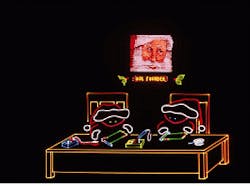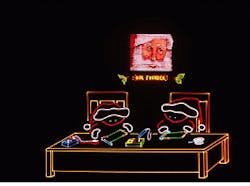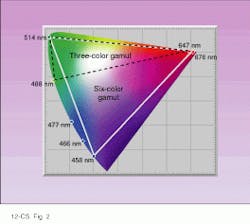Software stretches laser artists imagination
Software stretches laser artists` imagination
Patrick Murphy
Laser displays are everywhere, from the Olympics to small-town fairs and trade-show booths. In the past five years, improvements in the technology used to create graphics for these displays have made it much easier to produce high-quality shows.
Among the main advances has been the development of faster galvanometer scanners. Under computer control, the mirrors in these scanners direct laser beams to create graphics. Since 1992, speeds have increased almost threefold, allowing, for example, test pattern points to be shown at 30,000 pt/s as opposed to 12,000 pt/s. Thus more-complex drawings can be projected with less flicker.
Another improvement is the development of an easy-to-use color device, the polychromatic acousto-optic modulator, which can take a white-light input and controls eight different wavelengths simultaneously for output. The modulator replaces nine components, making it easy to build projectors capable of displaying millions of available colors. And the advent of industry standards developed by the International Laser Display Association (ILDA; Bradenton, FL) means companies can now exchange image frames and animations and be assured that their shows will look the same on any ILDA standard projector.
Finally, new software developments take advantage of these technology advances. Improved software packages make show creation easier and open up new features. While such features may seem simple to an audience accustomed to Jurassic Park-type graphics, to laserists (laser artists) previously resigned to working with slow vector images, they are revolutionary. Casey Stack of Laser Physics (Salt Lake City, UT) comments, "Finally, in the last five or six years, the laser graphics tools have caught up with the rest of the computer industry. The tools are now very usable, friendly, and exciting."
Projecting photos, new colors
One striking new capability is raster images. Previously, almost all projected laser graphics were cartoon-like vector outlines. But in 1995, Pangolin Laser Software (Manassas, VA) and Lightspeed Design Group (Bellevue, WA) developed a technique in which a digitized photograph can be instantly converted into raster lines projected by industry-standard galvanometer scanners (see Fig. 1). Owing to the very limited bandwidth of these scanners, about 5 kHz, resolution is only about 50 laser pixels (lasels) by 50 lines. But this is more than enough to create full-color, subtly shaded TV-like photos in a fraction of the time it formerly took an artist to draw cartoon-style drawings.
Another new software feature is hidden-line removal. While common in raster (TV and film) computer graphics, this capability has always been difficult for laser projection software where three-dimensional (3-D)objects are almost always depicted as wireframes. The vector-based laser graphics cannot use raster-derived hidden-line algorithms. Even two-dimensional (2-D) objects that pass in front of other objects are transparent and not solid. Now, however, in the Lasergraph DSP system from Laser Animations (Berlin, Germany) both 2-D and 3-D objects can occlude those behind them. As with raster images, this gives laser-projected graphics the realism that viewers have come to expect from film and TV computer graphics.
Laser displays are noted for their striking colors and intense, high-contrast images. Software is helping to nearly double the choices in colors and to give much deeper blues and purer purples. These are achieved by going beyond traditional three-channel red-green-blue (RGB) color models. In the continuous-wave gas lasers used for most graphics, there are a number of discrete wavelengths (see cover photo). In the blue region, the strongest line is a cyan blue at 488 nm, with weaker, but deeper, more-saturated color lines at 477 nm (blue) and 458 nm (violet). In an RGB system, the blues are quite pale, because the "less blue" cyan line must be used to get adequate brightness.
To improve blue, Pangolin has introduced a six-channel color system--red, yellow, green, cyan, dark blue, and violet. Thus, if an image requires the dark blue of, say, a Pepsi logo, just the dedicated dark-blue channel can be used. Looking at a International Commission on Illumination (CIE) chromaticity diagram, the entire bottom half of the color gamut is now opened up to never-before-available colors (see Fig. 2).
Interestingly, the six-color software model has also led to improvements in laser hardware. In the "white light" (argon-krypton ion) lasers used for full-color displays, the amount of energy produced in the red, green, and blue regions was approximately equal. But because the eye has a much greater sensitivity to green wavelengths, the beam from these lasers appeared green. After noting the results from the six-color model, Lexel Laser (Fremont, CA) developed the first "photopically" color-balanced argon-krypton laser featuring 60% red, 15% green, and 25% blue output. This laser gives laser artists a well-balanced white, for more-accurate color rendition to the eye.
Dance to the music
A laser show is more than just realistic, colorful images. The images need to be synchronized with music, a task being approached in two complementary ways. A performance-based system such as the Lasergraph DSP or Choreographics by Laser Images (Van Nuys, CA) allows the laserist to actually run the laser graphics, "playing live," while recording standard MIDI (musical-instrument digital interface) control signals. A playlist of segments then recreates the edited performance along with the time-coded synchronized music.
Timeline-based systems developed by Pangolin, analogous to widely used multimedia programs such as Macromind Director or Adobe Premiere, are geared for studio assembly of a display. The artist puts images and effects together on a timeline, stretching or compressing the timeline segments to fit the music. For playback, the timeline is automatically synchronized to an audio CD in the computer`s CD-ROM drive or to the timecode from an external tape.
Other software advances
In the past few years, there have been many other software advances. With computer-aided-design-like drawing programs, it is easier to create 3-D logos, text, drawings, and animations. Faster scanners and software using multiple tracks need only one projector to display, rather than two or three. And shows can be created or updated on the road, without a projector, with the ability to preview a show on a laptop screen and play the soundtrack from compact disks or from waveform and MIDI files (see Fig. 3).
Stephen Harvey of Laser Magic (Seaford, England) says, "It used to take us so long to program, we lost the incentive halfway through. Now, it takes less time to do shows much more complex than what we did even three years ago. The software has improved beyond all recognition."
It is, of course, the heart and soul of the artist that makes or breaks a laser show. But with the tools now available, laser artists can worry less about technology and spend more time polishing their artistic visions. o
FIGURE 1. Until 1995, laser displays using galvanometer scanners were limited to vector (outline) drawings. New rasterizing software can turn a bitma¥into a low-resolution but recognizable photograph that can be shown on standard laser projectors. This laser-projected graphic combines traditional vector drawing for the North Pole worksho¥with raster techniques for the Santa portrait.
FIGURE 2. Previously, laser software controlled only three color channels, limiting available colors to the to¥of the chromaticity diagram (dotted lines). Software that addresses six color channels adds independent control of dee¥blues and violets, opening u¥a much wider range of colors (solid lines). Wavelengths indicated are the principal wavelengths of "white-light" (argon-krypton ion) lasers.


